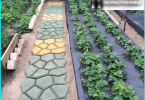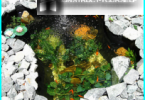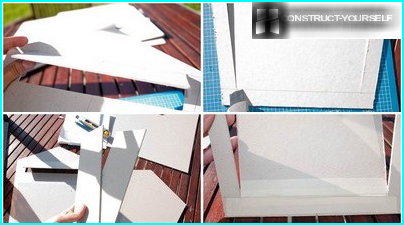
Country pond resembles a small world in which bubbling has its own special life: develop and blossom of the plant, scurry underwater inhabitants, every day happens something new. To ensure the viability of the reservoir should be cleaned at least occasionally one of the common ways is using a skimmer, vacuum, pump stations or improvised devices. For gentle cleaning of the water from the sludge is sufficient to collect the filter for a pond with their hands and connect it to the mains.
The contents
Do all pond filtration?
There are several conflicting opinions about whether to install in the pond an additional cleaning device. Proponents of natural cleaning think filter natural pond makes no sense, because within it is everything is provided by nature itself.
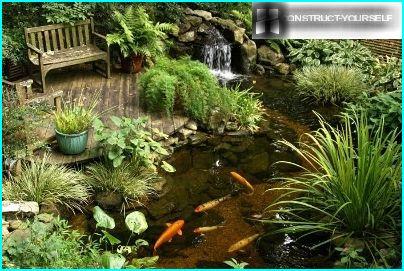
Picturesque, beautiful pond with transparent, crystal clear water – the result of a lot of work for cleaning of debris, silt and algae
Equilibrium is established thanks to a useful «marsh» plants that perform a number of useful features:
- bring in water, oxygen;
- block the development of harmful algae;
- enrich the environment necessary chemical elements;
- increase the transparency of the water;
- are the perfect decor.
For a small area of ponds are suitable Urrutia pigweed and bog autumn, for larger ponds – the canadian and Ceratophyllum. Representatives of underwater fauna also are a kind of cleaners. For example, crayfish and grass carps feed on duckweed and other polluting algae.
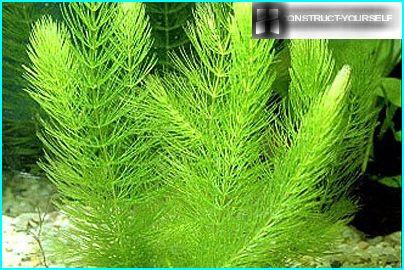
Dark green hornwort, a popular aquarium plant, has proven itself as an orderly ponds. Thrive in any climate, grows quite quickly
In ponds, artificially created on the film material, often used means of biological treatment containing cleaning bacteria. They kill algae, but not suitable for ponds in which fish are bred. One of the gentle solutions is the use of peat mixes that make the water less harsh and prevent the development of algae.
Many believe that without human intervention is not necessary. Be sure to clean the surface of the water dry twigs and grass, fallen leaves and other debris. If the water is too murky and polluted, it is necessary to use special pumping station, which will be very costly, or IED, which is much cheaper and affordable. Consider a homemade filter for garden pond, which can be done quickly and inexpensively.
Option #1 — filter out food baskets
What are the only things that don’t fit dexterous gardeners for their inventions! As capacity filter will fit any reservoir with holes, into which you can put filter components. Homemade filter great established itself during the cleaning of the pond with a mirror size of 2.5 m x 3.5 m.
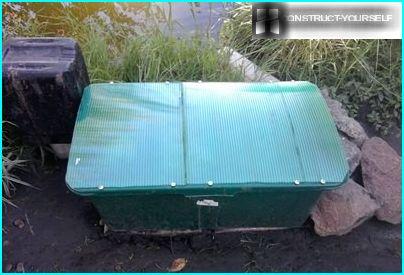
The top case is sealed with a piece of durable plastic or thick, folded in several layers, films and fixed with screws, wires or clamps
A list of required materials:
- plastic grocery basket medium size as the body;
- drain traps;
- submersible pump Atman AT-203;
- silicone sealant;
- cushioning polenta;
- fitting+nut (brass set);
- 2 of the clamp;
- pieces of foam;
- 4 hard sponges;
- the hose from the PVC (1 m).
Many of these materials can easily be found in the country, others are sold in the supermarket building. Pump Atman AT series-200 has a chance to buy in the store «All for aquariums». Pump perfectly clean water and at the same time enriches it with oxygen. To adjust the power attached to several devices. Submersible motor operates safely and has a low noise level. The device runs on 220V, has a power of 38w. For a small unit has acceptable capacity – 2000 l/h. ideal for ponds with a depth up to 2 meters.
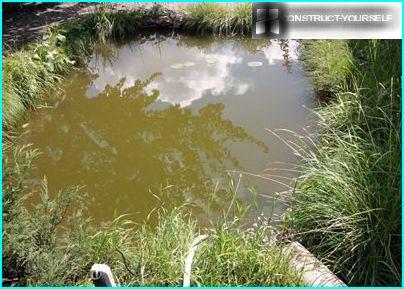
The pond, half cleared of algae. The water is still muddy and has a greenish tint, but is harmful to plants is no longer observed, and the bottom free of silt
The filter component can be any material that absorbs or check mud: clay, Packed in agrotextile; foam mats, twisted rolls; plastic mats with holes; old washcloths.
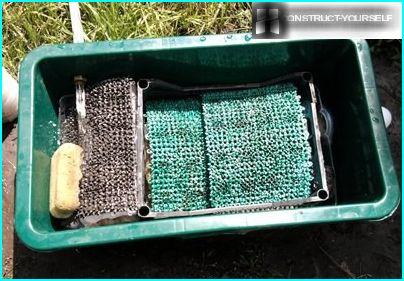
For convenience and further treatment of the filter material should be large, ideally the size of a basket
All layers loaded into the container (the basket), then using a sealant is attached to the siphon and hose.
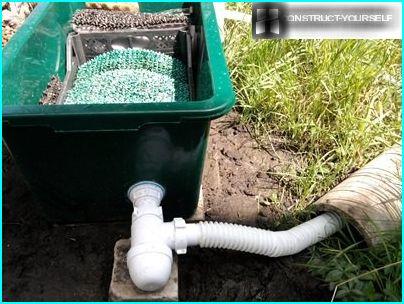
The hole for the siphon is drilled from the side to the water is freely received in the filter. The connection of the siphon with the body should be thoroughly coat sealant
Pump is immersed in water and connected to the network. For security purposes, the socket should be Packed in waterproof casing.
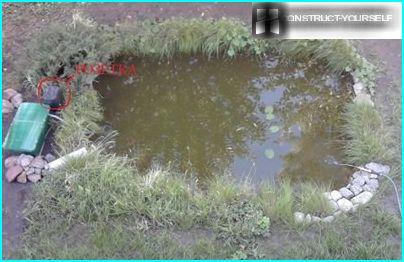
Any network connection should be tightly closed from the external environment. The casing can be made of durable plastic, thick piece of rubber or leather
Overflow do not necessarily – in the case of contamination of the filter the water naturally flow over the edge and will go down the drain.
Option #2 — filter out of a plastic bucket
Second homemade filter for pond is a submersible device that must be installed on the bottom of the pond. The volume of the pond is about 5 m?, depth – 1 m. the Design can be any, but the selected option is the most cheap and functional, reminiscent of the factory filters are sold in the shop.
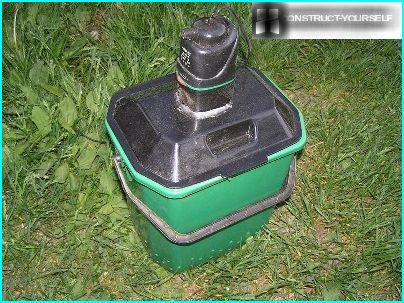
General view of the makeshift filter device, the housing with the filter material (foam) and cover with a fixed aquarium pump
Anyone who is engaged or at least interested in aquariums, there are several popular models of pumps. One of the most successful Polish device AQUAEL FAN 2. It’s advantages lie in its technical features: reliability, creating the desired flow, great flow and atomization air.
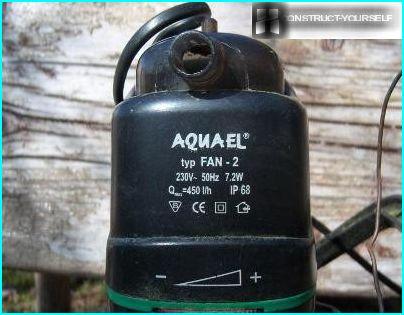
Pump has two main parts: housing filter housing with the engine (plus the regulator and hoses). It is powered from a standard 220 V power – 7.2 W
What to do the frame?
You will need a plastic bucket with capacity 10 ltr, playing the role of a housing for the filter element. It is desirable that the plastic was relatively durable and can withstand the load not less than 15 kg. for decorative purposes coloring «underwater» the bucket should match the color of the bottom, that is to be brown, grey or black.
For full operation requires a small revision. In the side walls of the bucket you need to drill holes of small diameter (4-5 mm) – they will bring water for cleaning. Some plastics brittle, so drilling must be done very carefully. In the lid you need to cut out a big hole to fix the filter. Also need a small vent for air to escape – another hole in the lid, but small– 3 mm.
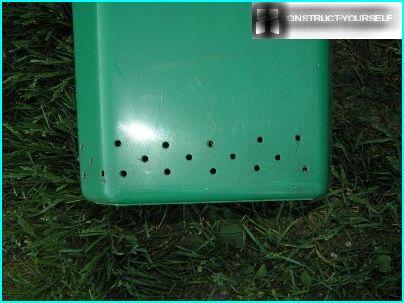
When calculating the diameter of the crossing hole you should consider the size of the particles of silt or debris which may block the flow of water to filter
The order of Assembly of the filter
As the filter material perfect foam – it is perfectly absorb moisture, hold dirt and easy to clean. The optimum thickness of the layers is 50 mm but you can use another format. Foam mats are used multiple times.
Assembly instructions:
- Fix the filter housing to the pump cover, using sealant or hot melt glue.
- Attach the pump housing to cover.
- Foam mats stacked along the walls of the bucket. On the bottom put two or three stones with a total weight of 5 kg as the weighting.
- Fill remainder of the bucket with foam.
- Fasten the lid using wire or clamps.
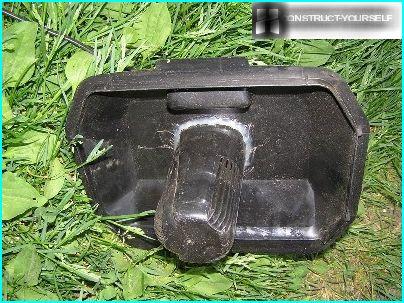
A thick layer of waterproof sealant or hot-melt glue will protect the connection cover and the body of the pump from water penetration in the upper part of the device
Connection and installation of the unit
For operation, the device must be connected to the mains of 220 V. the Connection of plugs and sockets should be protected from any moisture. For this you can use a cover of water repellent material. RCD installed on the line works in case of leakage current and will disconnect the network.
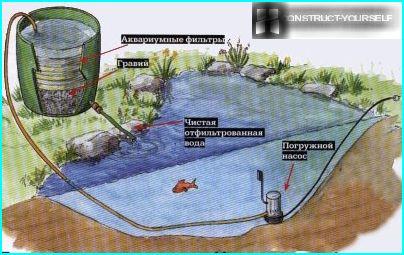
The diagram shows the water cycle in the cleaning process under the influence of the pump it enters the filter, and then purified, back into the pond
To set a filter you need to choose a smooth area of the bottom, mostly in deep place. Drop the filter into water, after which it naturally sink to the bottom of the reservoir.
Then connect the power supply and equip the place of the exit water after cleaning. For aeration to the pump you must attach a thin hose which second end will be above the water.
There are many versions of the self-made filters to clean the pond and to increase the performance of each craftsman can make something functional and useful.



